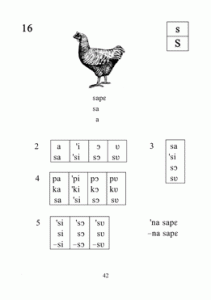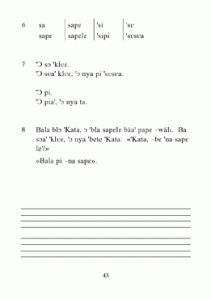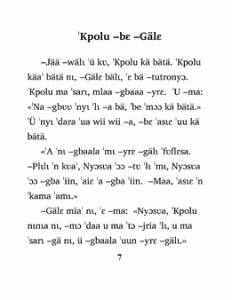Moving from an oral society to a society in which writing is an essential part of life takes many years, if not generations. Realizing this, our goal is to bring as many key Bakwé people as possible to the point of being able to read and write in in their language. This includes key people in each church community so the Bakwé Scriptures can be read out loud and heard by those who will not be able to learn to read in this generation.
For some, learning to read and write in Bakwé will open the door to learning to read and write in French. For others, a growing body of literature written in Bakwé will be sufficient enough. While we translate the Scriptures into Bakwé, we also continue to publish booklets in Bakwé on a number of subjects. Aside from Scripture and our Bakwé reading and writing primers, we have also published several dozen folktales, booklets on health, a couple of song books, some short stories, some history, and a bilingual dictionary. Samples of these documents can be downloaded at http://bakwe.org.
Starting in 2008 we will begin producing audio CD’s to go along with every title that we publish!
Developing The Alphabet
When we moved into the Bakwé village of Touadji-II, Bakwé was just a spoken language. Using our linguistic studies in phonetics, phonology and grammar analysis we analyzed Bakwé and developed an alphabet. As soon as we knew enough about the language, we published a reading and writing primer and a few folktales that are well known by everyone. A lesson of the reading and writing primer looks like this:
A Tonal Language
Bakwé reading and writing is easier to teach than English because each letter corresponds to only one sound in the language. The hardest part to teach is how to read and write the tones (the melody on the words). Bakwé is a tonal language. That means that the same word said with a different melody does not mean the same thing even though they have the same letters: “sapɛ”. The word “sapɛ” said with mid-tone on the first syllable, and high-tone on the second (MH) means “chicken”. The word “sapɛ” said with high-tone on the first syllable, and mid-tone on the second (HM) means “key”. Although there are three basic tone levels, it get’s a bit tricky when you combine them. The word “gbö” said with a Low-Mid tone glide means “five”, whereas saying it with a Low-High-Mid tone glide combination means “court yard” or “family”. What is worse is how do you write it?
Following the advice of the Institute of Applied Linguistics at the University of Abidjan, and based on the success of other alphabets in the country, we decided to write tone as follows:
High Tone with an apostrophe —-> ˈpa “play”
Mid Tone without a mark —-> pa “enter”
Low Tone with a hyphen —-> ‒pa “carve”
Example of words with tone combinations:
Mid-High —-> tuu (written with a doubled vowel, indicating that you either have to go up or down after the marked tone (in this case, Mid, which is marked by not being marked).
Low-High-Mid —-> ‒gbööö “courtyard, family” (starting tone is indicated on the first syllable; three “ö”s indicate that there is a glide combination)
High-Mid —-> ˈpaa “play” (imperfective form)
High-Mid-High —-> ˈpaaaˈ “play (imperf.) + subordinate clause marker, which is an affixed High-Tone “a”.”
Low-Low-Mid —-> ‒sröröfa “passage”
You will notice that with one exception we only write the starting tone of a word. The main reason for this is that there are a limited number of words that look the same, so a Bakwé person doesn’t need to have all the tones marked on the word. Only the starting tone is needed to know which word it is. For example, sapɛ (Mid-High) “chicken” is obiously different than ˈsapɛ (High-Mid); the one cannot be the other. However, if we didn’t indicate the first tone, the one could be mistaken for the other for someone reading the written word.
Here is a sample of a page taken from the folktale ˈKpolu ‒bɛ ‒Galɛ “Rat and Lizard”.


